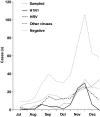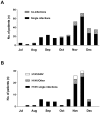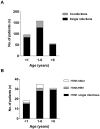Respiratory viruses in hospitalized children with influenza-like illness during the h1n1 2009 pandemic in Sweden [corrected]
- PMID: 23272110
- PMCID: PMC3522717
- DOI: 10.1371/journal.pone.0051491
Respiratory viruses in hospitalized children with influenza-like illness during the h1n1 2009 pandemic in Sweden [corrected]
Erratum in
- PLoS One. 2013;8(7). doi:10.1371/annotation/fcd5bca6-cbc4-493e-9083-d11903bcbc48
Abstract
Background: The swine-origin influenza A(H1N1)pdm09 pandemic of 2009 had a slower spread in Europe than expected. The human rhinovirus (HRV) has been suggested to have delayed the pandemic through viral interference. The importance of co-infections over time during the pandemic and in terms of severity of the disease needs to be assessed.
Objective: The aim of this study was to investigate respiratory viruses and specifically the presence of co-infections with influenza A(H1N1)pdm09 (H1N1) in hospitalized children during the H1N1 pandemic. A secondary aim was to investigate if co-infections were associated with severity of disease.
Methods: A retrospective study was performed on 502 children with influenza-like illness admitted to inpatient care at a pediatric hospital in Stockholm, Sweden during the 6 months spanning the H1N1 pandemic in 2009. Respiratory samples were analyzed for a panel of 16 viruses by real-time polymerase chain reaction.
Results: One or more viruses were detected in 61.6% of the samples. Of these, 85.4% were single infections and 14.6% co-infections (2-4 viruses). The number of co-infections increased throughout the study period. H1N1 was found in 83 (16.5%) children and of these 12 (14.5%) were co-infections. HRV and H1N1 circulated to a large extent at the same time and 6.0% of the H1N1-positive children were also positive for HRV. There was no correlation between co-infections and severity of disease in children with H1N1.
Conclusions: Viral co-infections were relatively common in H1N1 infected hospitalized children and need to be considered when estimating morbidity attributed to H1N1. Population-based longitudinal studies with repeated sampling are needed to improve the understanding of the importance of co-infections and viral interference.
Conflict of interest statement
Figures



References
-
- Dawood FS, Jain S, Finelli L, Shaw MW, Lindstrom, et al (2011) Emergence of a Novel Swine-Origin Influenza A (H1N1) Virus in Humans. N Eng J Med 360: 2605–2615. - PubMed
-
- Falagas ME, Cholevas NV, Kapaskelis AM, Vouloumanou EK, Michalopoulos A, et al. (2010) Epidemiological aspects of 2009 H1N1 influenza: the accumulating experience from the Northern Hemisphere. Eur J Microbiol Infect Dis 29: 1327–1347. - PubMed
-
- Swedish Institute for Communicable Disease Control (2010) Influensarapport vecka 1 (4/1–10/1). [article in swedish] http://smi.se/publikationer/veckorapporter/influensarapporter/sasongen20.... [cited 7 june 2012].
MeSH terms
LinkOut - more resources
Full Text Sources
Medical

